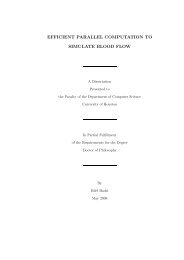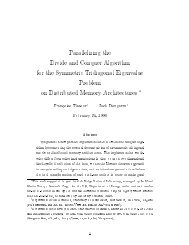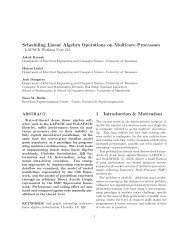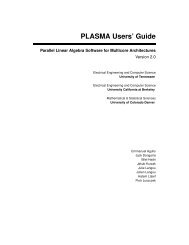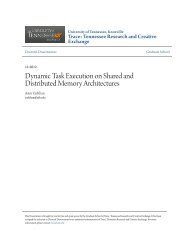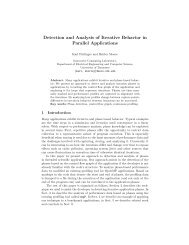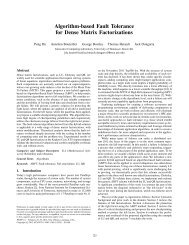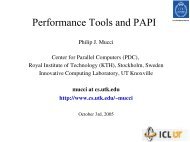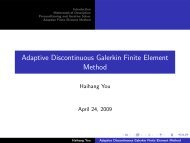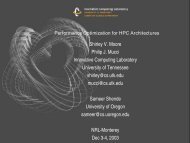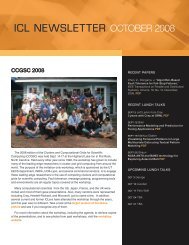Fast and Small Short Vector SIMD Matrix Multiplication ... - The Netlib
Fast and Small Short Vector SIMD Matrix Multiplication ... - The Netlib
Fast and Small Short Vector SIMD Matrix Multiplication ... - The Netlib
You also want an ePaper? Increase the reach of your titles
YUMPU automatically turns print PDFs into web optimized ePapers that Google loves.
<strong>Fast</strong> <strong>and</strong> <strong>Small</strong> <strong>Short</strong> <strong>Vector</strong> <strong>SIMD</strong> <strong>Matrix</strong> <strong>Multiplication</strong> Kernels<br />
for the Synergistic Processing Element of the CELL Processor<br />
– LAPACK Working Note 189<br />
Wesley Alvaro<br />
Department of Electrical Engineering <strong>and</strong> Computer Science, University of Tennessee<br />
Jakub Kurzak<br />
Department of Electrical Engineering <strong>and</strong> Computer Science, University of Tennessee<br />
Jack Dongarra<br />
Department of Electrical Engineering <strong>and</strong> Computer Science, University of Tennessee<br />
Computer Science <strong>and</strong> Mathematics Division, Oak Ridge National Laboratory<br />
School of Mathematics & School of Computer Science, University of Manchester<br />
ABSTRACT<br />
<strong>Matrix</strong> multiplication is one of the most common numerical<br />
operations, especially in the area of dense<br />
linear algebra, where it forms the core of many important<br />
algorithms, including solvers of linear systems<br />
of equations, least square problems, <strong>and</strong> singular<br />
<strong>and</strong> eigenvalue computations. <strong>The</strong> STI CELL<br />
processor exceeds the capabilities of any other processor<br />
available today in terms of peak single precision,<br />
floating point performance. In order to fully<br />
exploit the potential of the CELL processor for a<br />
wide range of numerical algorithms, fast implementation<br />
of the matrix multiplication operation is essential.<br />
<strong>The</strong> crutial component is the matrix multiplication<br />
kernel crafted for the short vector Single Instruction<br />
Multiple Data architecture of the Synergistic Processing<br />
Element of the CELL processor. In this paper,<br />
single precision matrix multiplication kernels are<br />
presented implementing the C = C − A × B T operation<br />
<strong>and</strong> the C = C − A × B operation for matrices of<br />
size 64×64 elements. For the latter case, the performance<br />
of 25.55 Gflop/s is reported, or 99.80 percent<br />
of the peak, using as little as 5.9 KB of storage for<br />
code <strong>and</strong> auxiliary data structures.<br />
KEYWORDS: CELL BE, matrix multiplication,<br />
SGEMM, SPE, short vector <strong>SIMD</strong><br />
1 Introduction<br />
<strong>The</strong> CELL Broadb<strong>and</strong> Engine Architecture (CBEA)<br />
has been developed jointly by the alliance of Sony,<br />
Toshiba <strong>and</strong> IBM (STI). <strong>The</strong> CELL processor is<br />
an innovative multi-core architecture consisting of<br />
a st<strong>and</strong>ard processor, the Power Processing Element<br />
(PPE), <strong>and</strong> eight short-vector Single Instruction<br />
Multiple Data (<strong>SIMD</strong>) processors, referred to as<br />
the Synergistic Processing Elements (SPEs). <strong>The</strong><br />
SPEs are equipped with scratchpad memory referred<br />
to as the Local Store (LS) <strong>and</strong> a Memory<br />
Flow Controller (MFC) to perform Direct Memory Access<br />
(DMA) transfers of code <strong>and</strong> data between the<br />
system memory <strong>and</strong> the Local Store.<br />
This paper is only concerned with the design of<br />
computational micro-kernels for the SPE in order to<br />
fully exploit Instruction Level Parallelism (ILP) provided<br />
by its <strong>SIMD</strong> architecture. Issues related to parallelization<br />
of code for execution on multiple SPEs,<br />
including intra-chip communication <strong>and</strong> synchronization,<br />
are not discussed here. SPE architercural details<br />
important to the discussion are presented in<br />
§5.1 <strong>and</strong> also throughout the text, as needed. Plentiful<br />
information about the design of the CELL processor<br />
<strong>and</strong> CELL programming techniques is in public<br />
the domain [1, 2].<br />
1
2 Motivation<br />
<strong>The</strong> current trend in processor design is towards<br />
chips with multiple processing units, commonly referred<br />
to as multi-core processors [3–5]. It has been<br />
postulated that building blocks of future architectures<br />
are likely to be simple processing elements with<br />
shallow pipelines, in-order execution, <strong>and</strong> <strong>SIMD</strong> capabilities<br />
[6]. It has also been poited out that direct<br />
control over the memory hierarchy may be desired,<br />
<strong>and</strong> software-managed scratchpad memory may be<br />
superior to traditional caches [6].<br />
It can be observed that the Synergistic Processing<br />
Element of the CELL processor closely matches this<br />
description. <strong>The</strong>re is no doubt that future processors<br />
will differ significantly from the current designs <strong>and</strong><br />
will reshape the way of thinking about programming<br />
such systems. By the same token, investigation into<br />
micro-kernel development for the SPE may have a<br />
broader impact by providing an important insight into<br />
programming future multi-core architectures.<br />
2.1 Performance Considerations<br />
State of the art numerical linear algebra software utilizes<br />
block algorithms in order to exploit the memory<br />
hierarchy of traditional cache-based systems [7, 8].<br />
Public domain libraries such as LAPACK [9] <strong>and</strong><br />
ScaLAPACK [10] are good examples. <strong>The</strong>se implementations<br />
work on square or rectangular submatrices<br />
in their inner loops, where operations are encapsulated<br />
in calls to Basic Linear Algebra Subroutines<br />
(BLAS) [11], with emphasis on expressing the computation<br />
as Level 3 BLAS, matrix-matrix type, operations.<br />
Frequently, the call is made directly to the matrix<br />
multiplication routine GEMM. At the same time,<br />
all the other Level 3 BLAS can be defined in terms of<br />
GEMM <strong>and</strong> a small amount of Level 1 <strong>and</strong> Level 2<br />
BLAS [12].<br />
A lot of effort has been invested in optimized BLAS<br />
by hardware vendors as well as academic institutions<br />
thorugh projects such as ATLAS [13] <strong>and</strong> GotoBLAS<br />
[14]. At the same time, the inefficiencies<br />
of the BLAS layer have been pointed out [15] as<br />
well as the shortcomings of its fork-join parallelization<br />
model [16]. Owing to this, the emerging trend in<br />
linear algebra is towards the use of specialized data<br />
structures such as Block Data Layout (BDL) [17, 18]<br />
<strong>and</strong> the expression of algorithms directly in terms of<br />
specialized inner-kernels [19]. Although application<br />
of these techniques is not always straightforward,<br />
problems can be often remedied by novel algorithmic<br />
approaches [20, 21].<br />
<strong>The</strong> innovation in CELL software has been progressing<br />
faster than elsewhere, with direct use of<br />
inner-kernels, out-of-order execution <strong>and</strong> Block Data<br />
Layout being a common practice [22–24]. As a result,<br />
performance of algorithms comes much closer<br />
to the speed of GEMM for much smaller problem<br />
sizes [24]. Any improvement to the GEMM routine<br />
immediately benefits the entire algorithm, which<br />
makes the optimization of the GEMM routine yet<br />
more important for the CELL processor.<br />
2.2 Code Size Considerations<br />
In the current implementation of the CELL BE architecture,<br />
the SPEs are equipped with a Local Store of<br />
256 KB. It is a common practice to use tiles of 64×64<br />
elements for dense matrix operations in single precision<br />
[22–26]. Such tiles occupy a 16 KB buffer in<br />
the Local Store. Between six <strong>and</strong> eight buffers are<br />
necessary to efficiently implement even such a simple<br />
operation as matrix multiplication [22, 25, 26].<br />
Also, more complex operations, such as matrix factorizations,<br />
commonly allocate eight buffers [23, 24],<br />
which consume 128 KB of Local Store. In general,<br />
it is reasonable to assume that half of the Local<br />
Store is devoted to application data buffers. At the<br />
same, time the program may rely on library frameworks<br />
like ALF [27] or MCF [28], <strong>and</strong> utilize numerical<br />
libraries such as SAL [29], <strong>SIMD</strong> Math [30] or<br />
MASS [31], which consume extra space for the code.<br />
In the development stage, it may also be desirable to<br />
generate execution traces for analysis with tools like<br />
TATL TM [32] or Paraver [33], which require additional<br />
storage for event buffers. Finally, Local Store also<br />
houses the SPE stack, starting at the highest LS address<br />
<strong>and</strong> growing towards lower addresses with no<br />
overflow protection.<br />
2
It should be quite obvious that the Local Store is<br />
a scarse resource <strong>and</strong> any real-world application is<br />
facing the problem of fitting tightly coupled components<br />
together in the limited space. SPE code can<br />
be replaced at runtime <strong>and</strong> the mechanism of overlays<br />
[34] can be of assistance with dynamic code<br />
management. Nevertheless, the use of kernels of<br />
tens of thous<strong>and</strong>s of kilobytes in size (§3) does not<br />
seem adequate for other purposes than to implement<br />
micro-benchmarks.<br />
3 Related Work<br />
Little literature exists about implementing matrix operations<br />
using short-vector <strong>SIMD</strong> capabilities. Implementation<br />
of matrix multiplication C = C + A × B T<br />
using Intel Streaming <strong>SIMD</strong> Extensions (SSE) was<br />
reported by Aberdeen <strong>and</strong> Baxter [35].<br />
Analysis of performance considerations of various<br />
computational kernels for the CELL processor,<br />
including the GEMM kernel, was presented by<br />
Williams et al. [36, 37], with results based mostly on<br />
simulation.<br />
<strong>The</strong> first implementation of the matrix multiplication<br />
kernel C = A × B for the CELL processor<br />
was reported by Chen et al. [22]. Performance of<br />
25.01 Gflop/s was reported on a single SPE with register<br />
usage of 69. Presumably, the article describes<br />
the C language implementation publicly distributed<br />
with the IBM CELL SDK.<br />
More recently assembly language implementation<br />
of the matrix multiplication C = C − A × B was<br />
reported by Hackenberg[25, 26]. Performance of<br />
25.40 Gflop/s was reported. Register usage of 71<br />
can be established by inspection of the publicly available<br />
code.<br />
Both codes were developed using very aggressive<br />
unrolling, resulting in a single loop with a huge<br />
body of straight-line code. <strong>Multiplication</strong> of 64 × 64<br />
matrices requires 64 × 64 × 64 = 262144 multiplications<br />
<strong>and</strong> additions (or subtractions). In single<br />
precision, the calculation can be implemented by<br />
262144/4 = 65536 fused multiply-add (FMA) <strong>SIMD</strong><br />
operations or fused multiply-subtract (FNMS) <strong>SIMD</strong><br />
operations. Both codes place 4096 of these operations<br />
in the body of a loop, which iterates 16 times<br />
<strong>and</strong> results in the size of the first code of roughly<br />
32 KB <strong>and</strong> the size of the second one close to 26 KB.<br />
Since the first code is in C, the exact size is compiler<br />
dependent.<br />
CELL BLAS library released as part of the<br />
SDK 3.0 [38] includes an SPE SGEMM kernel for<br />
multiplication of 64 × 64 martices. <strong>The</strong> routine is not<br />
available in source form. <strong>The</strong> size of the object code<br />
is over 32 KB.<br />
4 Original Contribution<br />
In this publication, an implementation of the GEMM<br />
kernel C = C −A×B T is reported, which, to the best<br />
knowledge of the authors, has not been reported before.<br />
Also, an implementation of the GEMM kernel<br />
C = C − A × B is reported, which achieves better<br />
performance than the kernels reported before, <strong>and</strong><br />
at the same time occupies more than four times less<br />
space. It is also shown that the latter kernel is optimal,<br />
in the sense that neither performance can be<br />
further improved nor code size decreased.<br />
It is also the intention of the authors to demystify<br />
the topic by clearly explaining the careful analysis<br />
behind optimized implementation of computational<br />
micro-kernels exploiting <strong>SIMD</strong> ILP, VLIW-like,<br />
dual-issue <strong>and</strong> other low-level architectural features<br />
of the computational cores of the CELL processor.<br />
5 Implementation<br />
5.1 SPU Architecture Overview<br />
<strong>The</strong> core of the SPE is the Synergistic Processing<br />
Unit (SPU). <strong>The</strong> SPU [39–41] is a RISC-style<br />
<strong>SIMD</strong> processor feturing 128 general purpose registers<br />
<strong>and</strong> 32-bit fixed length instruction encoding.<br />
SPU includes instructions that perform single precision<br />
floating point, integer arithmetic, logicals, loads,<br />
stores, compares <strong>and</strong> branches. SPU includes nine<br />
execution units organized into two pipelines, referred<br />
3
to as the odd <strong>and</strong> even pipeline. Instructions are issued<br />
in-order <strong>and</strong> two independent instructions can<br />
be issued simultaneously if they belong to different<br />
pipelines (Table 1).<br />
Table 1: Selected odd <strong>and</strong> even pipeline instruction<br />
groups <strong>and</strong> their latencies.<br />
Instructions<br />
Pipeline<br />
Even Odd<br />
Latency<br />
(cycles)<br />
Single precision floating point<br />
<br />
6<br />
Immediate loads,<br />
logical operations,<br />
integer add/subtract<br />
<br />
2<br />
Element rotates <strong>and</strong> shifts<br />
<br />
4<br />
Byte shuffles,<br />
quadword rotates <strong>and</strong> shifts<br />
Loads/stores,<br />
branch hints<br />
<br />
4<br />
<br />
6<br />
Branches<br />
<br />
4<br />
SPU executes code form the Local Store <strong>and</strong> operates<br />
on data residing in the Local Store, which is a<br />
fully pipelined, single-ported, 256 KB of Static R<strong>and</strong>om<br />
Access Memory (SRAM). Load <strong>and</strong> store instructions<br />
are performed within local address space,<br />
which is untranslated, unguarded <strong>and</strong> noncoherent<br />
with respect to the system address space. Loads<br />
<strong>and</strong> stores transfer 16 bytes of data between the register<br />
file <strong>and</strong> the Local Store, <strong>and</strong> complete with fixed<br />
six-cycle delay <strong>and</strong> without exception.<br />
SPU does not perform hardware branch prediction<br />
<strong>and</strong> omits branch history tables. Instead, the<br />
SPU includes a Software Managed Branch Target<br />
Buffer (SMBTB), which holds a single branch target<br />
<strong>and</strong> is loaded by software. A mispredicted branch<br />
flushes the pipelines <strong>and</strong> costs 18 cycles. A correctly<br />
hinted branch can execute in one cycle. Since both<br />
branch hint <strong>and</strong> branch instructions belong to the<br />
odd pipeline, proper use of SMBTB can result in zero<br />
overhead from branching for a compute-intensive<br />
loop dominated by even pipeline instructions.<br />
5.2 Loop Construction<br />
<strong>The</strong> main tool in loop construction is the technique<br />
of loop unrolling [42]. In general, the purpose of<br />
loop unrolling is to avoid pipeline stalls by separating<br />
dependent instructions by a distance in clock cycles<br />
equal to the corresponding pipeline latencies.<br />
It also decreases the overhead associated with advancing<br />
the loop index <strong>and</strong> branching. On the SPE it<br />
serves the additional purpose of balancing the ratio<br />
of instructions in the odd <strong>and</strong> even pipeline, owing to<br />
register reuse between interations.<br />
In the canonical form, matrix multiplication<br />
C m×n = A m×k ×B k×n coinsists of three nested loops<br />
iterating over the three dimensions m, n <strong>and</strong> k. Loop<br />
tiling [43] is applied to improve the locality of reference<br />
<strong>and</strong> to take advantage of the O(n 3 )/O(n 2 ) ratio<br />
of arithmetic operations to memory accesses. This<br />
way register reuse is maximized <strong>and</strong> the number of<br />
loads <strong>and</strong> stores is minimized.<br />
Conceptually, tiling of the three loops creates<br />
three more inner loops, which calculate a product<br />
of a submatrix of A <strong>and</strong> a submatrix of B <strong>and</strong> updates<br />
a submatrix of C with the partial result. Practically,<br />
the body of these three inner loops is subject to<br />
complete unrolling to a single block of a straight-line<br />
code. <strong>The</strong> tile size is picked such that the cross-over<br />
point between arithmetic <strong>and</strong> memory operations is<br />
reached, which means that there is more FMA or<br />
FNMS operations to fill the even pipeline than there<br />
is load, store <strong>and</strong> shuffle operations to fill the odd<br />
pipeline.<br />
<strong>The</strong> resulting structure consists of three outer<br />
loops iterating over tiles of A, B <strong>and</strong> C. Inevitably,<br />
nested loops induce mispredicted branches, which<br />
can be alleviated by further unrolling. Aggressive<br />
unrolling, however, leads quickly to undesired code<br />
bloat. Instead, the three-dimensional problem can<br />
be linearized by replacing the loops with a single<br />
loop performing the same traversal of the iteration<br />
space. This is accomplished by traversing tiles of A,<br />
B <strong>and</strong> C in a predefined order derived as a function<br />
of the loop index. A straightforward row/column<br />
ordering can be used <strong>and</strong> tile pointers for each iteration<br />
can be constructed by simple transformations of<br />
the bits of the loop index.<br />
4
At this point, the loop body still contains auxiliary<br />
operations that cannot be overlapped with arithmetic<br />
operations. <strong>The</strong>se include initial loads, stores of final<br />
results, necessary data rearrangement with splats<br />
<strong>and</strong> shuffles, <strong>and</strong> pointer advancing operations. This<br />
problem is addressed by double-buffering, on the<br />
register level, between two loop iterations. <strong>The</strong> existing<br />
loop body is duplicated <strong>and</strong> two separate blocks<br />
take care of the even <strong>and</strong> odd iteration, respectively.<br />
Auxiliary operations of the even iteration are hidden<br />
behind arithmetic instructions of the odd iteration<br />
<strong>and</strong> vice versa, <strong>and</strong> disjoint sets of registers are<br />
used where necessary. <strong>The</strong> resulting loop is preceeded<br />
by a small body of prologue code loading<br />
data for the first iteration, <strong>and</strong> then followed by a<br />
small body of epilogue code, which stores results of<br />
the last iteration. Figure 1 shows the optimization<br />
steps leading to a high performance implementation<br />
of the GEMM inner kernel.<br />
5.3 C = C – A × B trans<br />
FOR each element<br />
FOR each element<br />
FOR each element<br />
FOR each tile<br />
FOR each tile<br />
FOR each tile<br />
FOR each element<br />
FOR each element<br />
FOR each element<br />
FOR each tile – 1D space<br />
FOR each tile – 1D space<br />
FOR each tile – 1D space<br />
arithmetics & memory<br />
canonical<br />
form<br />
unrolling<br />
tiling<br />
<strong>The</strong> BLAS C = C − A × B T GEMM is a very<br />
common linear algebra operation. LAPACK relies<br />
on this operation for implementation of many matrix<br />
transformations, including Cholesky factorization<br />
( POTRF), LDL T factorization ( SYTRF), QR<br />
factorization ( GEQRF - calling GEMM indirectly<br />
through the LARFB routine), <strong>and</strong> bidiagonal reduction<br />
( GEBRD). <strong>The</strong> C = C − A × B T micro-kernel<br />
is also a building block for Level 3 BLAS routines<br />
other than GEMM, e.g., symmetric rank k update<br />
( SYRK).<br />
Specifically, implementation of the Cholesky factorization<br />
for the CELL processor, based on this<br />
micro-kernel coded in C, has been reported by the<br />
authors of this publication [24].<br />
Before going into details, it should be noted, that<br />
matrix storage follows C-style row-major format. It<br />
is not as much a carefull design decision, as compliance<br />
with the common practice on the CELL processor.<br />
It can be attributed to C compilers being the<br />
only ones allowing to exploit short-vector capabilities<br />
of the SPEs through C language <strong>SIMD</strong> extensions.<br />
If compliance with libraries relying on legacy<br />
FOR each tile – 3D space<br />
arithmetics & memory<br />
FOR each pair of tiles<br />
arithmetics<br />
(even iteration)<br />
arithmetics<br />
(odd iteration)<br />
memory<br />
(odd iteration)<br />
memory<br />
(even iteration)<br />
pieplining<br />
linearization<br />
(doublebuffering)<br />
Figure 1: Basic steps of GEMM loop optimization.<br />
FORTRAN API is required, a translation operation is<br />
necessary. However, translation is required anyway,<br />
since implementations of dense linear algebra routines<br />
on the CELL processor rely on Block Data Lay-<br />
5
out. Typically, the two conversions are combined in<br />
one operation, which introduces an acceptable overhead<br />
[23].<br />
An easy way to picture the C = C − A × B T operation<br />
is to represent it as the st<strong>and</strong>ard matrix vector<br />
product C = C − A × B, where A is stored using<br />
row-major order <strong>and</strong> B is stored using column-major<br />
order. It can be observed that in this case a row of<br />
A can readily be multiplied with a column of B to<br />
yield a vector containing four partial results, which<br />
need to be summed up to produce one element of<br />
C. <strong>The</strong> vector reduction step introduces superfluous<br />
multiply-add operations. In order to minimize their<br />
number, four row-column products are computed, resulting<br />
in four vectors, which need to be internally<br />
reduced. <strong>The</strong> reduction is performed by first transposing<br />
the 4 × 4 element matrix represented by the<br />
four vectors <strong>and</strong> then applying four vector multiplyadd<br />
operations to produce a result vector containing<br />
four elements of C. <strong>The</strong> basic scheme is depicted in<br />
Figure 2.<br />
A<br />
B<br />
C<br />
transpose<br />
reduce<br />
Figure 2: Basic operation of the C = C − A × B T<br />
matrix multiplication micro-kernel.<br />
<strong>The</strong> crucial design choice to be made is the right<br />
amount of unrolling, which is equivalent to deciding<br />
the right tile size in terms of the triplet {m, n, k} (Here<br />
sizes express numbers of individual floating-point<br />
values, not vectors). Unrolling is mainly used to minimize<br />
the overhead of jumping <strong>and</strong> advancing the index<br />
variable <strong>and</strong> associated pointer arithmetic. It has<br />
been pointed out in §5.1 that both jump <strong>and</strong> jump<br />
hint instructions belong to the odd pipeline <strong>and</strong>, for<br />
compute intensive loops, can be completely hidden<br />
behind even pipeline instructions <strong>and</strong> thus introduce<br />
no overhead. In terms of the overhead of advancing<br />
the index variable <strong>and</strong> related pointer arithmetic,<br />
it will be shown in §5.5 that all of these operations<br />
can be placed in the odd pipeline as well. In this situation,<br />
the only concern is balancing even pipeline,<br />
arithmetic instructions with odd pipeline, data manipulation<br />
instructions.<br />
Simple analysis can be done by looking at the<br />
number of floating-point operations versus the number<br />
of loads, stores <strong>and</strong> shuffles, under the assumption<br />
that the size of the register file is not a constraint.<br />
<strong>The</strong> search space for the {m, n, k} triplet is<br />
further truncated by the following criteria: only powers<br />
of two are considered in order to simplify the loop<br />
construction; the maximum possible number of 64<br />
is chosen for k in order to minimize the number of<br />
extraneous floating-point instructions performing the<br />
reduction of partial results; only multiplies of four are<br />
selected for n to allow for efficient reduction of partial<br />
results with eight shuffles per one output vector of C.<br />
Under these constraints, the entire search space can<br />
be easily analyzed.<br />
Table 2 shows how the number of each type of<br />
operation is calculated. Table 3 shows the number<br />
of even pipeline, floating-point instructions including<br />
the reductions of partial results. Table 4 shows<br />
the number of even pipeline instructions minus the<br />
number of odd pipeline instructions including loads,<br />
stores <strong>and</strong> shuffles (not including jumps <strong>and</strong> pointer<br />
arithmetic). In other words, Table 4 shows the number<br />
of spare odd pipeline slots before jumps <strong>and</strong><br />
pointer arithmetic are implemented. Finally, Table 5<br />
shows the size of code involved in calculations for<br />
a single tile. It is important to note here that the<br />
double-buffered loop is twice the size.<br />
It can be seen that the smallest unrolling with a<br />
positive number of spare odd pipeline slots is represented<br />
by the triplet {2, 4, 64} <strong>and</strong> produces a loop<br />
with 136 floating-point operations. However, this unrolling<br />
results in only 20 spare slots, which would<br />
6
Table 2: Numbers of different types of operations in<br />
the computation of one tile of the C = C − A × B T<br />
micro-kernel as a function of tile size ({m, n, 64}<br />
triplet).<br />
Type of<br />
Operation<br />
Pipeline<br />
Even<br />
Odd<br />
Number of<br />
Operations<br />
Floating point<br />
<br />
(m n 64) 4 + m n<br />
Load A<br />
<br />
m 64 4<br />
Load B<br />
<br />
64 n 4<br />
Table 3: Number of even pipeline, floating-point<br />
operations in the computation of one tile of the<br />
micro-kernel C = C − A × B T as a function of tile<br />
size ({m, n, 64} triplet).<br />
M/N 4 8 16 32 64<br />
1 68 136 272 544 1088<br />
2 136 272 544 1088 2176<br />
4 272 544 1088 2176 4352<br />
8 544 1088 2176 4352 8704<br />
16 1088 2176 4352 8704 17408<br />
32 2176 4352 8704 17408 34816<br />
64 4352 8704 17408 34816 69632<br />
Load C<br />
<br />
m n 4<br />
Store C<br />
<br />
m n 4<br />
Shuffle<br />
<br />
m n 4 8<br />
barely fit pointer arithmetic <strong>and</strong> jump operations. Another<br />
aspect is that the odd pipeline is also used<br />
for instruction fetch <strong>and</strong> near complete filling of the<br />
odd pipeline may cause instruction depletion, which<br />
in rare situations can even result in an indefinite<br />
stall [44].<br />
<strong>The</strong> next larger c<strong>and</strong>idates are triplets {4, 4, 64}<br />
<strong>and</strong> {2, 8, 64}, which produce loops with 272<br />
floating-point operations, <strong>and</strong> 104 or 72 spare odd<br />
pipeline slots, respectively. <strong>The</strong> first one is an obvious<br />
choice, giving more room in the odd pipeline<br />
<strong>and</strong> smaller code. It turns out that the {4, 4, 64} unrolling<br />
is actually the most optimal of all, in terms<br />
of the overall routine footprint, when the implementation<br />
of pointer arithmetic is taken into account, as<br />
further explained in §5.5.<br />
It can be observed that the maximum performance<br />
of the routine is ultimately limited by the<br />
extra floating-point operations, which introduce an<br />
overhead not accounted for in the formula for operation<br />
count in matrix multiplication: 2 × m ×<br />
n × k. For matrices of size 64 × 64, every 64<br />
multiply-add operations require four more operations<br />
to perform the intra-vector reduction. This<br />
sets a hard limit on the maximum achievable per-<br />
Table 4: Number of spare odd pipeline slots in the<br />
computation of one tile of the C = C − A × B T<br />
micro-kernel as a function of tile size ({m, n, 64}<br />
triplet).<br />
M/N 4 8 16 32 64<br />
1 22 28 40 64 112<br />
2 20 72 176 384 800<br />
4 104 272 608 1280 2624<br />
8 272 672 1472 3072 6272<br />
16 608 1472 3200 6656 13568<br />
32 1280 3072 6656 13824 28160<br />
64 2624 6272 13568 28160 57344<br />
Table 5: <strong>The</strong> size of code for the computation of one<br />
tile of the C = C − A × B T micro-kernel as a function<br />
of tile size ({m, n, 64} triplet).<br />
M/N 4 8 16 32 64<br />
1 1.2 1.2 2.3 4.5 8.9<br />
2 1.0 1.8 3.6 7.0 13.9<br />
4 1.7 3.2 6.1 12.0 23.8<br />
8 3.2 5.9 11.3 22.0 43.5<br />
16 6.1 11.3 21.5 42.0 83.0<br />
32 12.0 22.0 42.0 82.0 162.0<br />
64 23.8 43.5 83.0 162.0 320.0<br />
formance to 64/(64 + 4) × 25.6 = 24.09 [Gflop/s],<br />
which is roughly 94 % of the peak.<br />
7
5.4 C = C – A × B<br />
Perhaps the most important usage of the BLAS<br />
C = C − A × B GEMM operation is in Gaussian<br />
elimination. This operation is employed<br />
by LAPACK’s implementation of LU factorization<br />
( GETRF), which is also a basis for the Linpack<br />
benchmark [45] used to rank supercomputers on the<br />
Top500 list [46]. <strong>The</strong> C = C − A × B micro-kernel is<br />
also a building block for Level 3 BLAS routines other<br />
than GEMM, e.g., triangular solve ( TRSM).<br />
Specifically, implementation of LU factorization for<br />
the CELL processor, based on this micro-kernel<br />
coded in C has been reported by Chen et al. [22].<br />
Here, same as before, row major storage is assumed.<br />
<strong>The</strong> key observation is that multiplication of<br />
one element of A with one row of B contributes to<br />
one row of C. Owing to that, the elementary operation<br />
splats an element of A over a vector, multiplies<br />
this vector with a vector of B <strong>and</strong> accumulates the<br />
result in a vector of C (Figure 3). Unlike for the other<br />
kernel, in this case no extra floating-point operations<br />
are involved.<br />
splat<br />
A<br />
B<br />
C<br />
each type of operation is calculated. Table 7 shows<br />
the number of even pipeline, floating-point instructions.<br />
Table 8 shows the number of even pipeline instructions<br />
minus the number of odd pipeline instructions<br />
including loads, stores <strong>and</strong> splats (not including<br />
jumps <strong>and</strong> pointer arithmetic). In other words, Table<br />
8 shows the number of spare odd pipeline slots before<br />
jumps <strong>and</strong> pointer arithmetic are implemented.<br />
Finally, Table 9 shows the size of code involved in<br />
calculations for a single tile. It is should be noted<br />
again that the double-buffered loop is twice the size.<br />
It can be seen that the smallest unrolling with<br />
a positive number of spare odd pipeline slots produces<br />
a loop with 128 floating-point operations. Five<br />
possibilities exist, with the triplet {4, 16, 8} providing<br />
the highest number of 24 spare odd pipeline slots.<br />
Again, such unrolling would both barely fit pointer<br />
arithmetic <strong>and</strong> jump operations <strong>and</strong> be a likely cause<br />
of instruction depletion.<br />
<strong>The</strong> next larger c<strong>and</strong>idates are unrollings producing<br />
loops with 256 floating-point operations. <strong>The</strong>re<br />
are 10 such cases, with the triplet {4, 32, 8} being<br />
the obvious choice for the highest number of 88<br />
spare odd pipeline slots <strong>and</strong> the smallest code size.<br />
It also turns out that this unrolling is actually the most<br />
optimal in terms of the overall routine footprint, when<br />
the implementation of pointer arithmetic is taken into<br />
account, as further explained in §5.5.<br />
Unlike for the other routine, the maximum performance<br />
is not limited by any extra floating-point<br />
operations, <strong>and</strong> performance close to the peak of<br />
25.6 Gflop/s should be expected.<br />
Figure 3: Basic operation of the C = C−A×B matrix<br />
multiplication micro-kernel.<br />
Same as before, the size of unrolling has to be decided<br />
in terms of the triplet {m, n, k}. This time, however,<br />
there is no reason to fix any dimension. Nevertheless,<br />
similar constraints to the search space apply:<br />
all dimensions have to be powers of two, <strong>and</strong><br />
additionally only multiplies of four are allowed for n<br />
<strong>and</strong> k to facilitate efficient vectorization <strong>and</strong> simple<br />
loop construction. Table 6 shows how the number of<br />
5.5 Advancing Tile Pointers<br />
<strong>The</strong> remaining issue is the one of implementing the<br />
arithmetic calculating the tile pointers for each loop<br />
iteration. Due to the size of the input matrices <strong>and</strong><br />
the tile sizes being powers of two, this is a straightforward<br />
task. <strong>The</strong> tile offsets can be calculated from the<br />
tile index <strong>and</strong> the base addresses of the input matrices<br />
using integer arithmetic <strong>and</strong> bit manipulation<br />
instructions (bitwise logical instructions <strong>and</strong> shifts).<br />
Figure 4 shows a sample implementation of pointer<br />
arithmetic for the kernel C = C − A × B T with un-<br />
8
Table 6: Numbers of different types of operations in<br />
the computation of one tile of the C = C − A × B<br />
micro-kernel as a function of tile size ({m, n, k}).<br />
Type of<br />
Operation<br />
Pipeline<br />
Even<br />
Odd<br />
Number of<br />
Operations<br />
Floating point<br />
<br />
(m n k) 4<br />
Load A<br />
<br />
m k 4<br />
Load B<br />
<br />
k n 4<br />
Load C<br />
<br />
m n 4<br />
Store C<br />
<br />
m n 4<br />
Splat<br />
<br />
m k<br />
Table 8: Number of spare odd pipeline slots in the<br />
computation of one tile of the C = C − A × B<br />
micro-kernel as a function of tile size ({m, n, k}).<br />
K M/N 4 8 16 32 64<br />
4 1 7 9 13 21 37<br />
4 2 10 10 10 10 10<br />
4 4 16 12 4 12 44<br />
4 8 28 16 8 56 152<br />
4 16 52 24 32 144 368<br />
4 32 100 40 80 320 800<br />
4 64 196 72 176 672 1664<br />
8 1 12 14 18 26 42<br />
8 2 16 12 4 12 44<br />
8 4 24 8 24 88 216<br />
8 8 40 0 80 240 560<br />
8 16 72 16 192 544 1248<br />
4 32 136 48 416 1152 2624<br />
4 64 264 112 864 2368 5376<br />
16 1 22 24 28 36 52<br />
16 2 28 16 8 56 152<br />
16 4 40 0 80 240 560<br />
16 8 64 32 224 608 1376<br />
16 16 112 96 512 1344 3008<br />
16 32 208 224 1088 2816 6272<br />
16 64 400 480 2240 5760 12800<br />
Table 7: Number of even pipeline operations in the<br />
computation of one tile of the micro-kernel C = C −<br />
A × B as a function of tile size ({m, n, k}).<br />
K M/N 4 8 16 32 64<br />
4 1 4 8 16 32 64<br />
4 2 8 16 32 64 128<br />
4 4 16 32 64 128 256<br />
4 8 32 64 128 256 512<br />
4 16 64 128 256 512 1024<br />
4 32 128 256 512 1024 2048<br />
4 64 256 512 1024 2048 4096<br />
8 1 8 16 32 64 128<br />
8 2 16 32 64 128 256<br />
8 4 32 64 128 256 512<br />
8 8 64 128 256 512 1024<br />
8 16 128 256 512 1024 2048<br />
8 32 256 512 1024 2048 4096<br />
8 64 512 1024 2048 4096 8192<br />
16 1 16 32 64 128 256<br />
16 2 32 64 128 256 512<br />
16 4 64 128 256 512 1024<br />
16 8 128 256 512 1024 2048<br />
16 16 256 512 1024 2048 4096<br />
16 32 512 1024 2048 4096 8192<br />
16 64 1024 2048 4096 8192 16384<br />
Table 9: <strong>The</strong> size of code for the computation of one<br />
tile of the C = C − A × B micro-kernel as a function<br />
of tile size ({m, n, k}).<br />
K M/N 4 8 16 32 64<br />
4 1 0.1 0.1 0.2 0.3 0.6<br />
4 2 0.1 0.2 0.3 0.5 1.0<br />
4 4 0.2 0.3 0.5 1.0 1.8<br />
4 8 0.4 0.6 1.0 1.8 3.4<br />
4 16 0.7 1.1 1.9 3.4 6.6<br />
4 32 1.4 2.2 3.7 6.8 12.9<br />
4 64 2.8 4.3 7.3 13.4 25.5<br />
8 1 0.1 0.2 0.3 0.6 1.2<br />
8 2 0.2 0.3 0.5 1.0 1.8<br />
8 4 0.3 0.5 0.9 1.7 3.2<br />
8 8 0.7 1.0 1.7 3.1 5.8<br />
8 16 1.3 1.9 3.3 5.9 11.1<br />
4 32 2.5 3.8 6.4 11.5 21.8<br />
4 64 5.0 7.6 12.6 22.8 43.0<br />
16 1 0.2 0.3 0.6 1.1 2.2<br />
16 2 0.4 0.6 1.0 1.8 3.4<br />
16 4 0.7 1.0 1.7 3.1 5.8<br />
16 8 1.3 1.9 3.1 5.6 10.6<br />
16 16 2.4 3.6 6.0 10.8 20.3<br />
16 32 4.8 7.1 11.8 21.0 39.5<br />
16 64 9.6 14.1 23.3 41.5 78.0<br />
9
olling corresponding to the triplet {4, 4, 64}. Abase,<br />
Bbase <strong>and</strong> Cbase, are base addresses of the input<br />
matrices <strong>and</strong> the variable tile is the tile index running<br />
from 0 to 255; Aoffs, Boffs <strong>and</strong> Coffs are the calculated<br />
tile offsets.<br />
Figure 5 shows the result of compiling the sample<br />
C code from Figure 4 to assembly code. Although<br />
a few variations are possible, the resulting assembly<br />
code will always involve a similar combined number<br />
of integer <strong>and</strong> bit manipulation operations. Unfortunately,<br />
all these instructions belong to the even<br />
pipeline <strong>and</strong> will introduce an overhead, which cannot<br />
be hidden behind floating point operations, like it<br />
is done with loads, stores, splats <strong>and</strong> shuffles.<br />
One way of minimizing this overhead is extensive<br />
unrolling, which creates a loop big enough to make<br />
the pointer arithmetic negligible. An alternative is to<br />
eliminate the pointer arithmetic operations from the<br />
even pipeline <strong>and</strong> replace them with odd pipeline operations.<br />
With the unrolling chosen in §5.3 <strong>and</strong> §5.4,<br />
the odd pipeline offers empty slots in abundance.<br />
It can be observed that, since the loop boundaries<br />
are fixed, all tile offsets can be calculated in advance.<br />
At the same time, the operations available<br />
in the odd pipeline include loads, which makes it a<br />
logical solution to precalculate <strong>and</strong> tabulate tile offsets<br />
for all iterations. It still remains necessary to<br />
combine the offsets with the base addresses, which<br />
are not known beforeh<strong>and</strong>. However, under additional<br />
alignment constraints, offsets can be combined<br />
with bases using shuffle instructions, which<br />
are also available in the odd pipeline. As will be further<br />
shown, all instructions that are not floating point<br />
arithmetic can be removed from the even pipeline.<br />
int tile;<br />
vector float *Abase;<br />
vector float *Bbase;<br />
vector float *Cbase;<br />
vector float *Aoffs;<br />
vector float *Boffs;<br />
vector float *Coffs;<br />
Aoffs = Abase + ((tile & ~0x0F)
processed next (preceeding in memory). In other<br />
words, the iteration variable, which also serves as<br />
the index to the lookup table, is tabulated along<br />
with the offsets <strong>and</strong> loaded instead of being decremented.<br />
A0 B0 C0 A1 B1 C1 xxx xxx<br />
AN-2 BN-2 CN-2 AN-3 BN-3 CN-3 0x0 N-4<br />
AN BN CN AN-1 BN-1 CN-1 0x0 N-2<br />
Figure 6: Organization of the tile offset lookup table.<br />
N is the number of tiles.<br />
Normally, the tile pointers would have to be calculated<br />
as a sum of an 18-bit base address <strong>and</strong> a<br />
14-bit offset, which would require the use of integer<br />
addition residing in the even pipeline. With the additional<br />
constraint of 16 KB alignment of the base addresses,<br />
14 less significant bits of the base are zero<br />
<strong>and</strong> can be simply replaced with the bits of the offset.<br />
<strong>The</strong> replacement could be implemented with the logical<br />
AND operation. This would however, again, involve<br />
an even pipeline instruction. Instead, both the<br />
base addresses <strong>and</strong> the offsets are initially shifted<br />
left by two bits, which puts the borderline between<br />
offsets <strong>and</strong> bases on a byte boundary. At this point<br />
the odd pipeline shuffle instruction operating at byte<br />
granularity can be used to combine the base with<br />
the offset. Finally, the result has to be shifted right<br />
by two bits, which can be accomplished by a combination<br />
of bit <strong>and</strong> byte quadword rotations, which<br />
also belong to the odd pipeline. Overall, all the operations<br />
involved in advancing the double-buffered<br />
loop consume 29 extra odd pipeline slots, which is<br />
small, given that 208 is available in the case of the<br />
first kernel <strong>and</strong> 176 in the case of the second.<br />
This way, all operations involved in advancing from<br />
tile to tile are implemented in the odd pipeline. At<br />
the same time, both the branch instruction <strong>and</strong> the<br />
branch hint belong to the odd pipeline. Also, a correctly<br />
hinted branch does not cause any stall. As a<br />
result, such an implementation produces a continuous<br />
stream of floating-point operations in the even<br />
pipeline, without a single cycle devoted to any other<br />
activity.<br />
<strong>The</strong> last issue to be discussed is the storage overhead<br />
of the lookup table. This size is proportional<br />
to the number of iterations of the unrolled loop <strong>and</strong><br />
reciprocal to the size of the loop body. Using the<br />
presented scheme (Figure 6), the size of the lookup<br />
table in bytes equals N 3 /(m × n × k) × 8. Table 10<br />
presents the overall footprint of the C = C − A × B T<br />
micro-kernel as a function of the tile size. Table 11<br />
presents the overall footprint of the C = C − A × B<br />
micro-kernel as a function of the tile size. As can be<br />
clearly seen, the chosen tile sizes result in the lowest<br />
possible storage requirements for the routines.<br />
Table 10: <strong>The</strong> overall footprint of the micro-kernel<br />
C = C − A × B T , including the code <strong>and</strong> the offset<br />
lookup table, as a function of tile size ({m, n, 64}<br />
triplet).<br />
M/N 4 8 16 32 64<br />
1 9.2 6.3 6.6 10.0 18.4<br />
2 6.0 5.7 8.1 14.5 28.0<br />
4 5.4 7.4 12.8 24.3 47.6<br />
8 7.4 12.3 22.8 44.1 87.1<br />
16 12.8 22.8 43.1 84.1 166.0<br />
32 24.3 44.1 84.1 164.0 324.0<br />
64 47.6 87.1 166.0 324.0 640.0<br />
5.6 Results<br />
Both presented SGEMM kernel implementations<br />
produce a continuous stream of floating-point instructions<br />
for the duration of the pipelined loop. In<br />
both cases, the loop iterates 128 times, processing<br />
two tiles in each iteration. <strong>The</strong> C = C − A × B T<br />
kernel contains 544 floating-point operations in the<br />
loop body <strong>and</strong>, on a 3.2 GHz processor, delivers<br />
25.54 Gflop/s (99.77 % of peak) if actual operations<br />
are counted, <strong>and</strong> 24.04 Gflop/s (93.90 % of peak)<br />
if the st<strong>and</strong>ard formula, 2N 3 , is used for operation<br />
11
Table 11: <strong>The</strong> overall footprint of the micro-kernel<br />
C = C − A × B, including the code <strong>and</strong> the offset<br />
lookup table, as a function of tile size ({m, n, 64}<br />
triplet).<br />
K M/N 4 8 16 32 64<br />
4 1 128.1 64.2 32.4 16.7 9.3<br />
4 2 64.2 32.3 16.6 9.1 6.1<br />
4 4 32.4 16.6 9.0 5.9 5.7<br />
4 8 16.7 9.1 5.9 5.6 7.8<br />
4 16 9.4 6.2 5.8 7.9 13.6<br />
4 32 6.8 6.3 8.4 14.0 26.0<br />
4 64 7.5 9.6 15.1 27.0 51.1<br />
8 1 64.2 32.4 16.6 9.2 6.3<br />
8 2 32.4 16.6 9.0 5.9 5.7<br />
8 4 16.7 9.1 5.8 5.3 7.3<br />
8 8 9.3 6.0 5.4 7.1 12.1<br />
8 16 6.6 5.9 7.5 12.3 22.5<br />
4 32 9.1 9.6 13.8 23.5 43.8<br />
4 64 12.1 16.1 25.8 45.8 86.1<br />
16 1 32.4 16.7 9.2 6.3 6.4<br />
16 2 16.7 9.1 5.9 5.6 7.8<br />
16 4 9.3 6.0 5.4 7.1 12.1<br />
16 8 6.5 5.8 7.3 11.8 21.5<br />
16 16 6.9 8.3 12.5 21.8 40.6<br />
16 32 10.6 14.8 23.8 42.1 79.1<br />
16 64 19.6 28.5 46.6 83.1 156.0<br />
count. <strong>The</strong> C = C − A × B kernel contains 512<br />
floating-point operations in the loop body <strong>and</strong> delivers<br />
25.55 Gflop/s (99.80 % of peak). Here, the actual<br />
operation count equals 2N 3 . At the same time, neither<br />
implementation overfills the odd pipeline, which<br />
is 31 % empty for the first case <strong>and</strong> 17 % empty for<br />
the second case. This guarantees no contention between<br />
loads <strong>and</strong> stores <strong>and</strong> DMA operations, <strong>and</strong><br />
no danger of instruction fetch starvation. Table 12<br />
shows the summary of the kernels’ properties.<br />
5.7 Conclusions<br />
Computational micro-kernels are architecture specific<br />
codes, where no portability is sought. It has<br />
been shown that systematic analysis of the problem<br />
combined with exploitation of low-level features<br />
of the Synergistic Processing Unit of the CELL processor<br />
leads to dense matrix multiplication kernels<br />
achieving peak performance without code bloat.<br />
Table 12: Summary of the properties of the SPE<br />
<strong>SIMD</strong> SGEMM mikro-kernels.<br />
Characteristic T C=CAB T C=CAB T<br />
Performance 24.04<br />
Gflop/s<br />
25.55<br />
Gflop/s<br />
Execution time 21.80 s 20.52 s<br />
Fraction of peak<br />
USING THE 2MNK FORMULA<br />
Fraction of peak<br />
USING ACTUAL NUMBER<br />
OF FLOATING–POINT INSTRUCTIONS<br />
Dual issue rate<br />
ODD PIPELINE WORKLOAD<br />
93.90 % 99.80 %<br />
99.77 % 99.80%<br />
68.75 % 82.81 %<br />
Register usage 69 69<br />
Code segment size 4008 3992<br />
Data segment size 2192 2048<br />
Total memory footprint 6200 6040<br />
5.8 Code<br />
<strong>The</strong> code is freely available, under the BSD license<br />
<strong>and</strong> can be downloaded from the author’s web site<br />
http://icl.cs.utk.edu/ ∼ alvaro/. A few comments can<br />
be useful here. In absence of better tools, the code<br />
has been developed with a help of a spreadsheet,<br />
mainly for easy manipulation of two columns of instructions<br />
for the two pipelines of the SPE. Other<br />
useful features were taken advantage of as well.<br />
Specifically, color coding of blocks of instructions<br />
greatly improves the readability of the code. It is<br />
the hope of the authors that such visual representation<br />
of code considerably helps the reader’s underst<strong>and</strong>ing<br />
of the techniques involved in construction<br />
of optimized <strong>SIMD</strong> assembly code. Also, the<br />
authors put considerable effort in making the software<br />
self-contained, in the sense that all tools involved<br />
in construction of the code are distributed<br />
alongside. That includes the lookup table generation<br />
code <strong>and</strong> the sripts facilitating translation from<br />
spreadsheet format to SPE assembly language.<br />
12
References<br />
[1] IBM Corporation. Cell BE Programming Tutorial,<br />
November 2007.<br />
[2] IBM Corporation. Cell Broadb<strong>and</strong> Engine Programming<br />
H<strong>and</strong>book, Version 1.1, April 2007.<br />
[3] S. Borkar. Design Challenges of Technology<br />
Scaling. IEEE Micro, 19(4):23–29, 1999.<br />
[4] D. Geer. Industry Trends: Chip Makers Turn to<br />
Multicore Processors. Computer, 38(5):11–13,<br />
2005.<br />
[5] H. Sutter. <strong>The</strong> Free Lunch Is Over: A Fundamental<br />
Turn Toward Concurrency in Software.<br />
Dr. Dobb’s Journal, 30(3), 2005.<br />
[6] K. Asanovic, R. Bodik, B. C. Catanzaro, J. J.<br />
Gebis, P. Husb<strong>and</strong>s, K. Keutzer, D. A. Patterson,<br />
W. L. Plishker, J. Shalf, S. W. Williams, <strong>and</strong><br />
K. A. Yelick. <strong>The</strong> L<strong>and</strong>scape of Parallel Computing<br />
Research: A View from Berkeley. Technical<br />
Report UCB/EECS-2006-183, Electrical Engineering<br />
<strong>and</strong> Computer Sciences Department,<br />
University of California at Berkeley, 2006.<br />
[7] J. J. Dongarra, I. S. Duff, D. C. Sorensen, <strong>and</strong><br />
H. A. van der Vorst. Numerical Linear Algebra<br />
for High-Performance Computers. SIAM, 1998.<br />
[8] J. W. Demmel. Applied Numerical Linear Algebra.<br />
SIAM, 1997.<br />
[9] E. Anderson, Z. Bai, C. Bischof, L. S. Blackford,<br />
J. W. Demmel, J. J. Dongarra, J. Du Croz,<br />
A. Greenbaum, S. Hammarling, A. McKenney,<br />
<strong>and</strong> D. Sorensen. LAPACK Users’ Guide.<br />
SIAM, 1992.<br />
[10] L. S. Blackford, J. Choi, A. Cleary,<br />
E. D’Azevedo, J. Demmel, I. Dhillon, J. J.<br />
Dongarra, S. Hammarling, G. Henry, A. Petitet,<br />
K. Stanley, D. Walker, <strong>and</strong> R. C. Whaley.<br />
ScaLAPACK Users’ Guide. SIAM, 1997.<br />
[11] Basic Linear Algebra Technical Forum. Basic<br />
Linear Algebra Technical Forum St<strong>and</strong>ard, August<br />
2001.<br />
[12] B. Kågström, P. Ling, <strong>and</strong> C. van Loan. GEMM-<br />
Based Level 3 BLAS: High-Performance Model<br />
Implementations <strong>and</strong> Performance Evaluation<br />
Benchmark. ACM Trans. Math. Soft.,<br />
24(3):268–302, 1998.<br />
[13] ATLAS. http://math-atlas.sourceforge.net/.<br />
[14] GotoBLAS. http://www.tacc.utexas.edu/<br />
resources/software/.<br />
[15] E. Chan, E. S. Quintana-Orti, G. Gregorio<br />
Quintana-Orti, <strong>and</strong> R. van de Geijn. Supermatrix<br />
Out-of-Order Scheduling of <strong>Matrix</strong><br />
Operations for SMP <strong>and</strong> Multi-Core Architectures.<br />
In Nineteenth Annual ACM Symposium<br />
on Parallel Algorithms <strong>and</strong> Architectures<br />
SPAA’07, pages 116–125, June 2007.<br />
[16] J. Kurzak <strong>and</strong> J. J. Dongarra. LAPACK Working<br />
Note 178: Implementing Linear Algebra<br />
Routines on Multi-Core Processors. Technical<br />
Report CS-07-581, Electrical Engineering <strong>and</strong><br />
Computer Science Department, University of<br />
Tennessee, 2006.<br />
[17] N. Park, B. Hong, <strong>and</strong> V. K. Prasanna. Analysis<br />
of Memory Hierarchy Performance of Block<br />
Data Layout. In International Conference on<br />
Parallel Processing, August 2002.<br />
[18] N. Park, B. Hong, <strong>and</strong> V. K. Prasanna. Tiling,<br />
Block Data Layout, <strong>and</strong> Memory Hierarchy Performance.<br />
IEEE Trans. Parallel Distrib. Syst.,<br />
14(7):640–654, 2003.<br />
[19] J. R. Herrero <strong>and</strong> J. J. Navarro. Using Nonlinear<br />
Array Layouts in Dense <strong>Matrix</strong> Operations. In<br />
Workshop on State-of-the-Art in Scientific <strong>and</strong><br />
Parallel Computing PARA’06, June 2006.<br />
[20] A. Buttari, J. Langou, J. Kurzak, <strong>and</strong> J. J. Dongarra.<br />
LAPACK Working Note 190: Parallel<br />
Tiled QR Factorization for Multicore Architectures.<br />
Technical Report CS-07-598, Electrical<br />
Engineering <strong>and</strong> Computer Science Department,<br />
University of Tennessee, 2007.<br />
13
[21] A. Buttari, J. Langou, J. Kurzak, <strong>and</strong> J. J. Dongarra.<br />
LAPACK Working Note 191: A Class<br />
of Parallel Tiled Linear Algebra Algorithms for<br />
Multicore Architectures. Technical Report CS-<br />
07-600, Electrical Engineering <strong>and</strong> Computer<br />
Science Department, University of Tennessee,<br />
2007.<br />
[22] T. Chen, R. Raghavan, J. Dale, <strong>and</strong> E. Iwata.<br />
Cell Broadb<strong>and</strong> Engine architecture <strong>and</strong> its<br />
first implementation, A performance view.<br />
http://www-128.ibm.com/developerworks/<br />
power/library/pa-cellperf/, November 2005.<br />
[23] J Kurzak <strong>and</strong> J. J. Dongarra. Implementation<br />
of Mixed Precision in Solving Systems of Linear<br />
Equations on the CELL Processor. Concurrency<br />
Computat.: Pract. Exper., 19(10):1371–<br />
1385, 2007.<br />
[24] J. Kurzak, A. Buttari, <strong>and</strong> J. J. Dongarra. Solving<br />
Systems of Linear Equation on the CELL<br />
Processor Using Cholesky Factorization. Trans.<br />
Parallel Distrib. Syst., 2008.<br />
[25] D. Hackenberg. Einsatz und Leistungsanalyse<br />
der Cell Broadb<strong>and</strong> Engine. Institut für Technische<br />
Informatik, Fakultät Informatik, Technische<br />
Universität Dresden, February 2007. Großer<br />
Beleg.<br />
[26] D. Hackenberg. <strong>Fast</strong> matrix multiplication<br />
on CELL systems. http://tu-dresden.de/<br />
die tu dresden/zentrale einrichtungen/zih/<br />
forschung/architektur und leistungsanalyse<br />
von hochleistungsrechnern/cell/, July 2007.<br />
[27] IBM Corporation. ALF for Cell BE Programmer’s<br />
Guide <strong>and</strong> API Reference, November<br />
2007.<br />
[28] M. Pepe. Multi-Core Framework (MCF), Version<br />
0.4.4. Mercury Computer Systems, October<br />
2006.<br />
[29] Mercury Computer Systems, Inc. Scientific Algorithm<br />
Library (SAL) Data Sheet, 2006. http:<br />
//www.mc.com/uploadedfiles/SAL-ds.pdf.<br />
[30] IBM Corporation. <strong>SIMD</strong> Math Library API Reference<br />
Manual, November 2007.<br />
[31] IBM Corporation. Mathematical Acceleration<br />
Subsystem - product overview. http:<br />
//www-306.ibm.com/software/awdtools/mass/,<br />
March 2007.<br />
[32] Mercury Computer Systems, Inc. Trace Analysis<br />
Tool <strong>and</strong> Library (TATL TM ) Data Sheet, 2006.<br />
http://www.mc.com/uploadedfiles/tatl-ds.pdf.<br />
[33] European Center for Parallelism of Barcelona,<br />
Technical University of Catalonia. Paraver, Parallel<br />
Program Visualization <strong>and</strong> Analysis Tool<br />
Reference Manual, Version 3.1, October 2001.<br />
[34] IBM Corporation. Software Development Kit 2.1<br />
Programmer’s Guide, Version 2.1, March 2007.<br />
[35] D. Aberdeen <strong>and</strong> J. Baxter. Emmerald: A <strong>Fast</strong><br />
<strong>Matrix</strong>-<strong>Matrix</strong> Multiply Using Intel’s SSE Instructions.<br />
Concurrency Computat.: Pract. Exper.,<br />
13(2):103–119, 2001.<br />
[36] S. Williams, J. Shalf, L. Oliker, S. Kamil, P. Husb<strong>and</strong>s,<br />
<strong>and</strong> K. Yelick. <strong>The</strong> Potential of the Cell<br />
Processor for Scientific Computing. In ACM<br />
International Conference on Computing Frontiers,<br />
2006.<br />
[37] S. Williams, J. Shalf, L. Oliker, S. Kamil, P. Husb<strong>and</strong>s,<br />
<strong>and</strong> K. Yelick. Scientific Computing Kernels<br />
on the Cell Processor. Int. J. Parallel Prog.,<br />
35(3):263–298, 2007.<br />
[38] IBM Corporation. Basic Linear Algebra Subprograms<br />
Programmer’s Guide <strong>and</strong> API Reference,<br />
November 2007.<br />
[39] B. Flachs, S. Asano, S. H. Dhong, P. Hofstee,<br />
G. Gervais, R. Kim, T. Le, P. Liu, J. Leenstra,<br />
J. Liberty, B. Michael, H. Oh, S. M. Mueller,<br />
O. Takahashi, A. Hatakeyama, Y. Watanabe,<br />
<strong>and</strong> N. Yano. A Streaming Processing Unit<br />
for a CELL Processor. In IEEE International<br />
Solid-State Circuits Conference, pages 134–<br />
135, 2005.<br />
14
[40] B. Flachs, S. Asano, S. H. Dhong, H. P. Hofstee,<br />
G. Gervais, K. Roy, T. Le, L. Peichun, J. Leenstra,<br />
J. Liberty, B. Michael, O. Hwa-Joon,<br />
S. M. Mueller, O. Takahashi, A. Hatakeyama,<br />
Y. Watanabe, N. Yano, D. A. Brokenshire,<br />
M. Peyravian, T. V<strong>and</strong>ung, <strong>and</strong> E. Iwata. <strong>The</strong><br />
Microarchitecture of the Synergistic Processor<br />
for a Cell Processor. IEEE J. Solid-State Circuits,<br />
41(1):63–70, 2006.<br />
[41] M. Gschwind, H. P. Hofstee, B. Flachs, M. Hopkins,<br />
Y. Watanabe, <strong>and</strong> T. Yamazaki. Synergistic<br />
Processing in Cell’s Multicore Architecture.<br />
IEEE Micro, 26(2):10–24, 2006.<br />
[42] J. L. Hennessy <strong>and</strong> D. A. Patterson. Computer<br />
Architecture, Fourth Edition: A Quantitative Approach.<br />
Morgan Kaufmann, 2006.<br />
[43] S. Muchnick. Advanced Compiler Design <strong>and</strong><br />
Implementation. Morgan Kaufmann, 1997.<br />
[44] IBM Corporation. Preventing Synergistic Processor<br />
Element Indefinite Stalls Resulting from<br />
Instruction Depletion in the Cell Broadb<strong>and</strong> Engine<br />
Processor for CMOS SOI 90 nm, Applications<br />
Note, Version 1.0, November 2007.<br />
[45] J. J. Dongarra, P. Luszczek, <strong>and</strong> A. Petitet. <strong>The</strong><br />
LINPACK Benchmark: Past, Present <strong>and</strong> Future.<br />
Concurrency Computat.: Pract. Exper.,<br />
15(9):803–820, 2003.<br />
[46] TOP500 Supercomputing Sites. http://www.<br />
top500.org/.<br />
15



